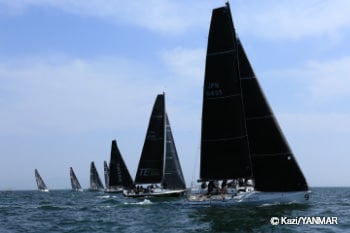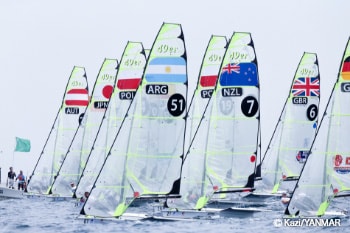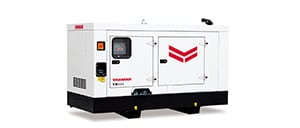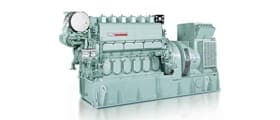Types of Sailing Competitions (Sailing Races)
In Sailing races, sailors compete against other boats for speed by using wind power received by their sails to generate propulsion without the use of engines, motors, or any other power source.
Olympic sailing competitions and other dinghy races are called one-design class, in which boats of the same type are used to decide the ranking according to the order of arrival. The series race format is the most common, with 2 to 5 races per regatta (one event), and often more than 10 races. For example, the boat that comes in first place gets 1 point, second place gets 2 points, and so on. The scores for all races are totaled and ranked from the lowest total score to first.
Sailboats come in a variety of sizes and shapes, and the number of people on board and their competitiveness will vary depending on their requirements. Therefore, while there are one-design class races, when boats of various sizes and types race against each other, as in the Yanmar Cup, the rating* is established and the rankings are determined by time modification multiplied by a handicap factor calculated from the rating. For example, if two boats finish in the same 30 minutes, boat A with a handicap of 0.9 and boat B with a handicap of 0.8 have different scores: boat A takes 27 minutes (30 x 0.9) and boat B takes 24 minutes (30 x 0.8); boat B with a shorter race time will be ranked higher.
*Rating: A rating for each boat used in sailing races between different boat types. From this, a coefficient is calculated as a handicap for each boat, and the finishing time is modified to ensure a fair race.

Cruiser (Keelboat)
- A small sailboat with a ballast keel (a weight in the center of the bottom) and no engine is called a keelboat.
- Boats equipped with engines and living quarters to run on the open sea are called cruisers or sailing cruisers.
- Basically, the sailboat is sailed by a large group of 3 or more people, each in charge of a role. There are also races for one rider, single-handed and two riders, double-handed.
- In addition to one-design class, handicap races in which different boat types compete using ratings are also popular.

Dragon Class for 3 to 4 Crew
Keelboat was adopted as an Olympic sport from London Game in 1948 to Munich in 1972. The beautiful hull is unique to the Dragon class and remains a popular classic sailboat especially in Europe. It is also known to have many enthusiasts in royal families around the world. Yanmar supports this class of competition, and Yanmar Racing also races in this class.

J/70 for 3 to 4 crew
Keelboat by J-Boat (U.S.A.), which has a proven track record in the world of one-design class boats such as J/24 and J/22. The 6.93 meters long boat launched in 2012, and the easy transportation in a trailer is part of its appeal. With a modern concept equipped with a gennaker (asymmetrical spinnaker), this class has a very exciting racing scene with more than 1,500 boats launched in 25 countries around the world.

Melges 20 for 3 to 4 crew
As a minimal class of 6.096m one-design keelboat, it is gaining popularity in Japan. It is a next-generation keelboat equipped with the latest technology, including slider-type side stays and small jib furlers. The class rules require, among other things, that the sailor be an amateur helmsman, and it has become a gateway to success for the younger sailors.

HPR for 8 to 12 crew
Racing boats designed under the High-Performance Rule rating system. This light-displacement, high-speed planing type boat with an extremely wide and thin stern shape is the center of the current Grand Prix racing scene in Japan. It is truly a cruiser that is ahead of its time.

AC72 <11 crew>
The America's Cup is also known as the Formula 1 of the Seas. The AC72, a huge catamaran with a hull length of 72ft, was used in the 2013 competition. Equipped with underwater wings, it floats out of the water and glides at a speed of over 40 knots. It is fair to say that this exciting ride overturned the conventional conception of the America's Cup, or even sailing for that matter.
Dinghy Sailboat
- Small boats are used by juniors, high school students, intercollegiate athletes, national athletes, and at the Olympics.
- There are a variety of boat types, including one- and two-person boats, competing in what is essentially a one-design class.
- The boat is light and can change direction quickly. In hard conditions, they also ride the waves.
- 70 to 100 boats participating in a single race, and the sight of so many sailboats all lined up at the starting line at once is a sight to behold.

470 class for 2 crew
This class has been adopted as an Olympic sport. Japanese athletes have won medals in the past, and many more have also competed in the World Championships. In Japan, it has been adopted as an intercollegiate sport. It is a two-person boat, and one of the features is that the crew members have their bodies out of the boat to balance it. Usually two sails are lifted, one more when heading downwind.

Laser Class
The most popular single-handed for one-person class of boat, characterized by simple rigging with a single sail. It has long been in the Olympics and its popularity is probably due to the fact that it is ideal for competing in sailing skill itself, rather than the performance of the boat. With an overall length of 4.23m, her concept makes it suitable for beginners.

Moss Class
It is possible to build many different types of boats within this class rules. The current mainstream is boats with foiling system that allows the boat float and glide out of the water. High-speed sailing performance sets them apart from other dinghy sailboats. In 2016, the World Championships were held in Hayama, Kanagawa, bringing together 72 sailors from 13 countries. Yanmar was the proud main sponsor of the tournament.

49er class <2 crew>
High performance boat with huge mainsail and gennaker which is a sail used for chasing wind. It has been an Olympic event since 2000 in Sydney. The helmsman and two crew members, both wearing equipment called trapeze, sail the boat with their bodies outside the boat. The 49er FX class, which is a smaller sail, is the women's Olympic event.

Optimist (OP) Class <1-seater>
Currently, the smallest class of 2.31m in length approved by World Sailing, International Sailing Federation is raced by junior sailors up to 15 years old. The combination of a box-shaped hull and a single sail makes the boat highly stable even in strong winds and easy to maneuver, making it ideal for the beginners. Over 150,000 children from 100 countries is actively sailing in this class.

RED BULL Foiling Generation <2-seater>
This series of races was first held in 2015 for the next generation in youth sailing from age of 16 to 20. It was created to train sailors to acquire skills on state-of-the-art foiling boats, Flying Phantoms, leading to the Youth America's Cup and to the America's Cup.
What is the Dragon Class?
With a history of 90 years, this sailing sport has a long tradition, having been adopted as an Olympic sport from 1948 to 1972. Dragon class associations have been established in more than 30 countries around the world, making it a competitive class with many enthusiasts worldwide. The International One-Design Class is 8.90 meters long and has the same standards for sail area, mast length, and maximum gross weight of the crew. Sailing skills and experience, rather than the performance of the race boat or the physical strength of the sailors, will determine the winner. Participants compete in races held around the world, and their annual ranking shows the champion by the points they earn throughout the year. Many big-name sailors have competed in the Olympics and the America's Cup, and the Dragon class is longed for by sailors.

 Agriculture
Agriculture
 Tractor
Tractor
 Solis Tractor
Solis Tractor
 Combine harvester
Combine harvester
 Rice transplanter
Rice transplanter
 Tiller
Tiller
 Agricultural Utility Equipment
Agricultural Utility Equipment
 Recreational Marine
Recreational Marine
 Marine Commercial
Marine Commercial
 Compact Equipment
Compact Equipment
 Excavator
Excavator
 Industrial Engine
Industrial Engine
 Compact Power Products
Compact Power Products
 Energy Systems
Energy Systems
 Power Generation
Power Generation


